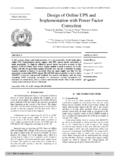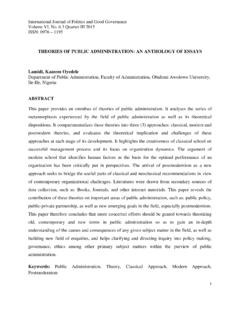Transcription of Pavement Deterioration and its Causes - IOSR …
1 IOSR Journal of Mechanical & Civil engineering (IOSR-JMCE) ISSN: 2278-1684, PP: 09-15 second International conference on Emerging Trends in engineering (SICETE) 9 | Page College of engineering , Jaysingpur Pavement Deterioration and its Causes , (Civil, college fo engineering / Shivaji University,India) (Civil, college fo engineering / Shivaji University,India) ABSTRACT: - In this paper Pavement failure is defined in terms of decreasing serviceability caused by the development of cracks and ruts. Before going into the maintenance strategies, we must look into the Causes of failure of bituminous pavements. Failures of bituminous pavements are caused due to many reasons or combination of reasons.
2 Application of correction in the existing surface will enhance the life of maintenance works as well as that of strengthening layer. It has been seen that only 3 parameters unevenness index, Pavement cracking and rutting are considered while other distresses have been omitted while going for maintenance operations. Along with the maintenance techniques there are various methods for Pavement preservation which will help in enhancing the life of Pavement and delaying of its failure. The purpose of this study was to evaluate the possible Causes of Pavement distresses, and to recommend remedies to minimize distress of the Pavement . The paper describes lessons learnt from Pavement failures and problems experienced during the last few years on a number of projects in India.
3 Based on the past experiences various Pavement preservation techniques and measures are also discussed which will be helpful in increasing the serviceable life of Pavement . Keywords: - Pavement , unevenness index, rutting, distresses. I. INTRODUCTION Meaning of Pavement That with which anything is paved; a floor or covering of solid material, laid so as to make a hard and convenient surface for travel; a paved road or sidewalk; a decorative interior floor of tiles colored bricks. Types of Pavement Pavements are typically divided into the following three general categories: flexible, rigid and unpaved (gravel or dirt). Flexible (Bituminous Pavements) Flexible pavements are constructed of several layers of natural granular material covered with one or more waterproof bituminous surface layers, and as the name imply, is considered to be flexible.
4 A flexible Pavement will flex (bend) under the load of a tyre. The objective with the design of a flexible Pavement is to avoid the excessive flexing of any layer, failure to achieve this will result in the over stressing of a layer, which ultimately will cause the Pavement to fail. In flexible pavements, the load distribution pattern changes from one layer to another, because the strength of each layer is different. The strongest material (least flexible) is in the top layer and the weakest material (most flexible) is in the lowest layer. The reason for this is that at the surface the wheel load is applied to a small area, the result is high stress levels, deeper down in the Pavement , the wheel load is applied to larger area, the result is lower stress levels thus enabling the use of weaker materials Fig 1.
5 Load distribution of flexible Pavement . Rigid (Concrete) Pavements: Rigid pavements are composed of a PCC surface course. Such pavements are substantially "stiffer" than flexible pavements due to the high modulus of elasticity of the PCC material. Further, Pavement Deterioration and its Causes second International conference on Emerging Trends in engineering (SICETE) 10 | Page College of engineering , Jaysingpur these pavements can have reinforcing steel, which is generally used to reduce or eliminate joints. The increased rigidity of concrete allows the concrete surface layer to bridge small weak areas in the supporting laye through what is known as beam action. This allows the placement of rigid pavements on relatively weak supporting layers, as long as the supporting layer material particles will not be carried away by water forced up by the pumping action of wheel loads.
6 Fig 2. Load distribution of rigid Pavement . Pavement Functions: The primary functions of a Pavement are to: PROVIDE A REASONABLY SMOOTH RIDING SURFACE: A smooth riding surface (Low Roughness) is essential for riding comfort, and over the years it has become the measure of how road users perceive a road. Roughness can arise from a number of Causes , most often however it is from Pavement distress due to structural deformation. PROVIDE ADEQUATE SURFACE FRICTION (SKID RESISTANCE): In addition to a riding comfort, the other road user requirement is that of safety. Safety, especially during wet conditions can be linked to a loss of surface friction between the tyre and the Pavement surface.
7 A Pavement must therefore provide sufficient surface friction and texture to ensure road user safety under all conditions. PROTECT THE SUBGRADE: The supporting soil beneath the Pavement is commonly referred to as the subgrade, should it be over-stressed by the applied axle loads it will deform and lose its ability to properly support these axle loads. Therefore, the Pavement must have sufficient structural capacity (strength and thickness) to adequately reduce the actual stresses so that they do not exceed the strength of the subgrade. The strength and thickness requirements of a Pavement can vary greatly depending on the combination of subgrade type and loading condition (magnitude and number of axle loads). PROVIDE WATERPROOFING: The Pavement surfacing acts as a waterproofing surface that prevent the underlaying support layers including the subgrade from becoming saturated through moisture ingress.
8 When saturated, soil loses its ability to adequately support the applied axle loads, which will lead to premature failure of the Pavement . II. FACTORS INFLUENCING THE PERFORMANCE OF A Pavement TRAFFIC: Traffic is the most important factor influencing Pavement performance. The performance of pavements is mostly influenced by the loading magnitude, configuration and the number of load repetitions by heavy vehicles. The damage caused per pass to a Pavement by an axle is defined relative to the damage per pass of a standard axle load, which is defined as a 80 kN single axle load (E80). Thus a Pavement is designed to withstand a certain number of standard axle load repetitions (E80 s) that will result in a certain terminal condition of Deterioration .
9 MOISTURE (WATER) Moisture can significantly weaken the support strength of natural gravel materials, especially the subgrade. Moisture can enter the Pavement structure through cracks and holes in the surface, laterally through the subgrade, and from the underlying water table through capillary action. The result of moisture ingress is the Pavement Deterioration and its Causes second International conference on Emerging Trends in engineering (SICETE) 11 | Page College of engineering , Jaysingpur lubrication of particles, loss of particle interlock and subsequent particle displacement resulting in Pavement failure. SUBGRADE The subgrade is the underlying soil that supports the applied wheel loads.
10 If the subgrade is too weak to support the wheel loads, the Pavement will flex excessively which ultimately Causes the Pavement to fail. If natural variations in the composition of the subgrade are not adequately addressed by the Pavement design, significant differences in Pavement performance will be experienced. CONSTRUCTION QUALITY Failure to obtain proper compaction, improper moisture conditions during construction, quality of materials, and accurate layer thickness (after compaction) all directly affect the performance of a Pavement . These conditions stress the need for skilled staff, and the importance of good inspection and quality control procedures during construction. MAINTENANCE Pavement performance depends on what, when, and how maintenance is performed.















